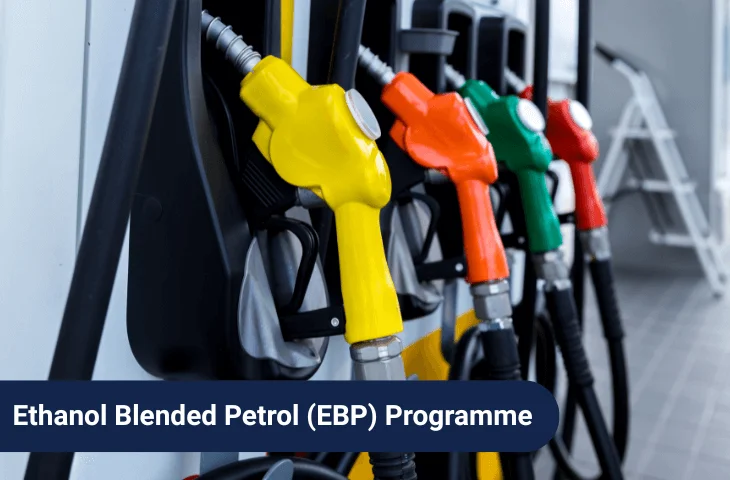The Ethanol Blended Petrol (EBP) Programme is a government initiative launched in 2003 to promote the use of ethanol as a biofuel in India’s transportation sector. The programme aims to blend ethanol with petrol, reducing dependence on imported crude oil and supporting energy security. It also encourages cleaner fuel usage, providing environmental benefits by lowering carbon emissions from vehicles.
Initially, the blending target was set at 5%, which gradually increased to 10% by 2022. The government later set a target of 20% ethanol blending (E20) by 2030. However, India achieved this target ahead of schedule in 2025, underlining the country’s commitment to renewable energy and sustainable development.
The programme is aligned with the National Policy on Biofuels and is implemented through Oil Marketing Companies (OMCs), which procure ethanol from domestic sources at government-fixed prices. Over time, the sources of ethanol have diversified from sugarcane molasses to include maize, bajra, surplus rice, and agricultural waste, creating a broader feedstock base and additional income for farmers.
How is Ethanol Produced for Blending?
Ethanol is a biofuel derived from agricultural products and certain chemical processes. In India, the primary source has traditionally been sugarcane, specifically molasses. With the expansion of the EBP Programme, ethanol production now also includes:
- Sugarcane juice and sugar syrup
- Maize and other cereals
- Damaged grains and surplus rice procured by FCI
- Agricultural residues, fruit and vegetable waste
Ethanol is considered renewable because it is plant-based. The production process involves fermentation of sugars, which yields ethyl alcohol suitable for blending with petrol. Advanced production technologies, including second-generation ethanol from lignocellulosic biomass, are being promoted under government initiatives like the PM-JI-VAN Yojana.
What is Ethanol Blending and Why is it Important?
Ethanol blending refers to mixing ethanol with petrol to create a fuel that is cleaner and more sustainable. For instance, E10 contains 10% ethanol, while E20 contains 20% ethanol by volume. The key importance of ethanol blending includes:
| Benefit | Details | Impact |
| Reducing Fossil Fuel Dependence | Replaces a portion of petrol with domestically produced ethanol, reducing crude oil imports. | Saved ~₹1.1 trillion in foreign exchange over the last decade |
| Environmental Benefits | Burns cleaner than gasoline, lowering harmful emissions and supporting climate goals. | Reduced CO, HC, and particulate matter; contributes to India’s Net-Zero 2070 target |
| Economic & Rural Benefits | Provides additional income for farmers, supports agro-industries, and generates employment. | ₹87,000 crore to farmers and ₹1,45,000 crore to distilleries (2014–2024) |
| Diversification of Crops | Encourages shift from water-intensive crops to biofuel feedstocks, promoting sustainable farming. | Promotes maize, sorghum, and other biofuel crops instead of rice/wheat |
| Industrial & Investment Growth | Attracts domestic and foreign investments in ethanol production through supportive policies. | Long-Term Ethanol Procurement Policy, Global Biofuels Alliance, ₹40,000 crore investments |
Also Check: List of Government Schemes of India
What is E20 Fuel and Its Significance?
E20 fuel is a blend of 20% ethanol and 80% petrol. The fuel was introduced in India at the India Energy Week 2023, with initial availability at 83 locations across 11 states and union territories.
| Aspect | Details |
| Significance of E20 Fuel | Reduces carbon emissions, promotes renewable energy, boosts engine performance, and supports farmers by converting leftover sugarcane and damaged grains into ethanol. |
| Environmental Impact | Cuts CO emissions (50% in two-wheelers, 30% in four-wheelers), reduces hydrocarbons by 20%, NOx largely unaffected. |
| Impact on Consumers & Vehicles | Slight reduction in fuel efficiency (1-7% depending on vehicle), engine and components need calibration; no major assembly changes required. |
Check Out: Complete List of Important Schemes for NABARD Grade A Exam
How does the EBP Programme Benefit India?
The programme impacts multiple sectors:
- Energy Security: Reduced import dependence shields India from global oil price volatility.
- Environment: Promotes clean energy, contributing to reduced air pollution and climate change mitigation.
- Agriculture and Rural Economy: Generates additional income for farmers and supports rural employment.
- Industrial Growth: Attracts investment in distilleries, ethanol infrastructure, and related technologies.
- Transportation Sector: Encourages the development of E20-compatible engines and fuel distribution networks.
Get ready to crack government job exams with leading educators
What Challenges does India Face in Ethanol Blending?
Despite its success, the EBP Programme faces several hurdles:
- Feedstock & Water: Heavy reliance on sugarcane/food grains; high water use.
- Production: Limited to sugarcane states; insufficient capacity.
- Pricing: Fixed prices create investment uncertainty.
- Logistics: Unequal availability; storage and transport risks.
- Vehicles: Most engines E10-compatible; E20 needs modification.
- Environment: Water-intensive; vinasse wastewater risk.
- Policy: Dependent on government incentives; vulnerable to changes.
What Measures can Strengthen Ethanol Blending in India?
To overcome challenges and accelerate implementation, several measures are proposed:
- Feedstock Diversification: Promote maize, sorghum, bamboo, and agricultural residues.
- Decentralized Ethanol Production: Encourage small rural distilleries linked with FPOs.
- R&D and Second-Generation Ethanol: Strengthen PM-JI-VAN Yojana for lignocellulosic ethanol.
- Vehicle Compatibility: Incentivize E20-compatible vehicles and retrofitting solutions.
- Pricing Mechanisms: Market-linked procurement and dynamic ethanol price stabilization fund.
- Water Efficiency: Promote water-efficient crops, drip irrigation (PM-Krishi Sinchayee Yojana), and ZLD in distilleries.
- Infrastructure Development: Expand ethanol-dedicated fuel pumps nationwide.
- Investment Promotion: Encourage FDI and private sector participation via EIDF and PPPs.
- Policy Coordination: Strengthen state policies, streamline approvals, align with National Green Hydrogen Mission.
Key Takeaways
| Aspect | Details |
| Launch Year | 2003 |
| Target | 5% initial, 10% by 2022, 20% by 2025 (achieved early) |
| Fuel Type | Ethanol blended with petrol (E10, E20) |
| Main Feedstocks | Sugarcane, maize, rice, agricultural residues |
| Benefits | Energy security, environmental sustainability, rural income, industrial growth |
| Challenges | Feedstock availability, water usage, vehicle compatibility, pricing, infrastructure |
| Government Schemes | PM-JI-VAN, National Bio-Energy Programme, PM-Krishi Sinchayee Yojana, GST reduction, EIDF |
| Environmental Impact | Reduced CO, HC emissions, partial NOx reduction, lower carbon footprint |
| Economic Impact | ₹1.1 trillion savings in foreign exchange, increased farmer income, investment in distilleries |
| Future Roadmap | Higher blending ratios, second-generation ethanol, decentralized production, integration with hybrid fuel solutions |
Questions Based on Ethanol Blended Petrol (EBP) Programme
- When was the Ethanol Blended Petrol (EBP) Programme launched in India?
a) 1999
b) 2000
c) 2003
d) 2005
e) 2010 - What is the current ethanol blending target achieved by India as of 2025?
a) 10%
b) 15%
c) 20%
d) 25%
e) 30% - Which of the following is a feedstock for ethanol production under the EBP Programme?
a) Coal
b) Sugarcane
c) Crude oil
d) LPG
e) Natural gas - Which scheme promotes second-generation ethanol production from agricultural residues?
a) PM-KISAN
b) PM-JI-VAN
c) FAME
d) EIDF
e) National Bio-Energy Mission - How much CO₂ emission reduction has the ethanol programme achieved since 2014?
a) 50 lakh tonnes
b) 544 lakh tonnes
c) 1000 lakh tonnes
d) 250 lakh tonnes
e) 10 lakh tonnes - Which organization procures surplus rice for ethanol production?
a) NABARD
b) FCI
c) ISRO
d) SEBI
e) NITI Aayog - What is the blend composition of E20 fuel?
a) 20% petrol + 80% ethanol
b) 20% ethanol + 80% petrol
c) 10% ethanol + 90% petrol
d) 50% ethanol + 50% petrol
e) 100% ethanol - Which of the following is NOT a benefit of ethanol blending?
a) Reduced carbon emissions
b) Enhanced energy security
c) Increased water consumption
d) Additional income for farmers
e) Industrial growth - Under which scheme are small-scale rural distilleries encouraged?
a) PM-JI-VAN
b) Mudra Yojana
c) FAME
d) EIDF
e) National Bio-Energy Programme - Which ministry/department is the nodal agency for ethanol production in India?
a) Ministry of Petroleum
b) Department of Food and Public Distribution
c) Ministry of Agriculture
d) Ministry of Environment
e) Ministry of Science and Technology
Also Read:
Answer Key
| Question Number | Correct Answer |
| 1 | c) 2003 |
| 2 | c) 20% |
| 3 | b) Sugarcane |
| 4 | b) PM-JI-VAN |
| 5 | b) 544 lakh tonnes |
| 6 | b) FCI |
| 7 | b) 20% ethanol + 80% petrol |
| 8 | c) Increased water consumption |
| 9 | b) Mudra Yojana |
| 10 | b) Department of Food and Public Distribution |
- MISHTI Scheme, India’s Initiative to Restore Mangrove Ecosystems
- National Green Hydrogen Mission Features, Objectives, and Benefits
- Paramparagat Krishi Vikas Yojana, Transforming India’s Organic Farming
- Mission on Integrated Development of Horticulture NHM and HMNEH
- Swachh Bharat Mission, India’s Journey Towards Cleanliness and Hygiene
- SAGY, A Step Towards Holistic Development of Indian Villages

Hi, I’m Aditi. I work as a Content Writer at Oliveboard, where I have been simplifying exam-related content for the past 4 years. I create clear and easy-to-understand guides for JAIIB, CAIIB, and UGC exams. My work includes breaking down notifications, admit cards, and exam updates, as well as preparing study plans and subject-wise strategies.
My goal is to support working professionals in managing their exam preparation alongside a full-time job and to help them achieve career growth.
